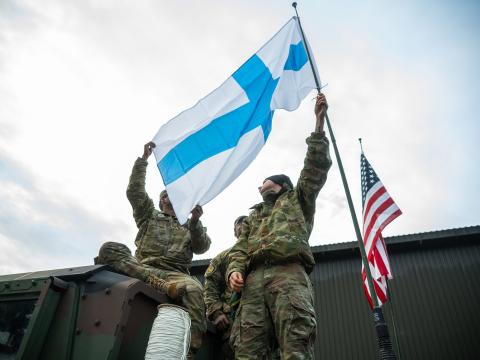Time for the Military to Take a Long, Hard Look
Military people like to look at themselves, and it has nothing to do with vanity. Rather, it is about improving, but the attention is not always welcome at the business end. Senior personnel offer the usual advice: Cooperate and learn. Do not be defensive. Looking at ourselves can only make us better, so we go along with it. And often—not always, but enough to matter—we find out important facts we did not know.
Military people like to look at themselves, and it has nothing to do with vanity. Rather, it is about improving, but the attention is not always welcome at the business end. Senior personnel offer the usual advice: Cooperate and learn. Do not be defensive. Looking at ourselves can only make us better, so we go along with it. And often—not always, but enough to matter—we find out important facts we did not know.
All of the men and women in our services know this well. The commitment among them to the after-action review (AAR) is strong. Army National Training Center rotations, Navy Top Gun iterations, Air Force Red Flag sequences and the Navy/Marine Corps COMPTUEX (Composite Training Unit Exercise) series end each major evolution with a gathering of all the key leaders. At these AARs, qualified senior observers, present for every phase of the preparation and action, lead a discussion focused on learning. In most cases, participants spend about a third of the time on what happened, another third sorting out why and the most important portion on figuring out how to fix what went wrong. This is a time-tested approach. It is done daily and nightly in outposts, orderly rooms, command centers and ready rooms around the world.
With this in mind, our young men and women in uniform raise a good question. The U.S. military has been fighting since September 11, 2001. The campaign in Iraq ended in December 2011. The one in Afghanistan wraps up in December of 2014. When are we having the AAR on the war?
It is not an unreasonable request. Journalists certainly have done their part, with books by Rajiv Chandrasekaran, Dexter Filkins, Michael Gordon and Bernard Trainor, Greg Jaffe, Sean Naylor, Martha Raddatz, Tom Ricks, Jake Tapper and Bob Woodward, among many others. These are well worth reading, but they represent the view from up in the press box. What is the word from down on the field, from those actually playing the game?
Some official attempts have taken place. In 2004, for example, the U.S. Army cranked out “On Point,” a well-illustrated, interesting account of the initial invasion of Iraq in 2003. A similar volume covered the dramatic opening of the Afghan campaign in 2001 and added a few chapters to cover events through 2005. “On Point II,” which continued the Iraq war narrative until January 2005, landed with a thud in 2008. To borrow from Apocalypse Now, it seems the brass did not dig what it was hearing. Since then, nothing has followed, absent the odd battle study or oral history collection.
It is not clear why little has been done. Certainly the war has generated more than enough domestic political fallout, with both major parties grinding axes about all kinds of issues. This includes blame for the 9/11 attacks, the nature of intelligence about Iraqi chemical weaponry and the adoption of a pair of grinding counterinsurgencies in two countries that are far from ripe for an outbreak of Jeffersonian democracy. Maybe it is too soon to forage through the underbrush of such contentious matters.
Others might worry about exposing military secrets. True, the arcane network diagram of the Jaysh-al-Mahdi’s bomb-makers in 2006 Sadr City may be more than ready for declassification. But in this era of Wikileaks, Zero Dark Thirty and Edward Snowden, most generals and admirals would rather just keep it all for later—much later.
However, a precedent exists for airing the truth. Even as World War II raged, with its outcome unknown, Gen. George C. Marshall, USA, authorized, resourced and supported a very thorough look at the U.S. Army’s effort in that global war—the famous Green Books. Distinguished historians such as Martin Blumenson, Maurice Matloff and Forrest Pogue gathered the facts and wrote it as they saw it. Many participants objected: Gen. Douglas MacArthur, USA, reportedly did not care for the section on Bataan; Gen. Mark Clark, USA, disliked the segment on Anzio. But thanks to Gen. Marshall, the results were printed anyway. The Green Books continue to serve us today.
Today’s war demands its own set of Green Books. Lacking a real AAR effort, we rely on folk memories. Some say the Iraq surge of 2007 proved counterinsurgency tactics worked. Others point out that today’s Iraq is a sectarian mess, undermining that belief. As for the Afghan surge of 2010-11, well, who knows? We cannot even say, or will not even say, who won these campaigns. It sure does not seem to be us.
You might think such an assessment might be rather useful as we prepare to carve up and rearrange our armed forces to face today’s uncertain world. Facts offer a better starting point than hunches, emotions and “the way we’ve always done it.” What did we learn from the current war? We owe it to the citizens we serve, and we certainly owe it to the men and women we have lost. We are past due for a long, hard look.
Lt. Gen. Daniel P. Bolger, USA (Ret.), is a former troop commander in Iraq and Afghanistan. The author of seven books and numerous articles, he currently teaches at North Carolina State University.




Comments